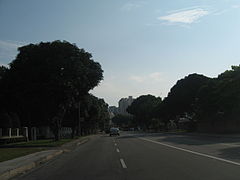Mountbatten | |
|---|---|
Subzone of Marine Parade Planning Area | |
| Name transcription(s) | |
| • Chinese | 蒙巴登 |
| • Pinyin | Méngbādēng |
| • Malay | Mountbatten |
| • Tamil | மவுண்ட்பேட்டன் |
 | |
| Coordinates: 1°18′51″N103°49′44″E / 1.3142°N 103.8288°E | |
| Country | Singapore |
Mountbatten (also known as Mountbatten Estate) [1] is a neighbourhood located in the planning area of Marine Parade, Singapore.





